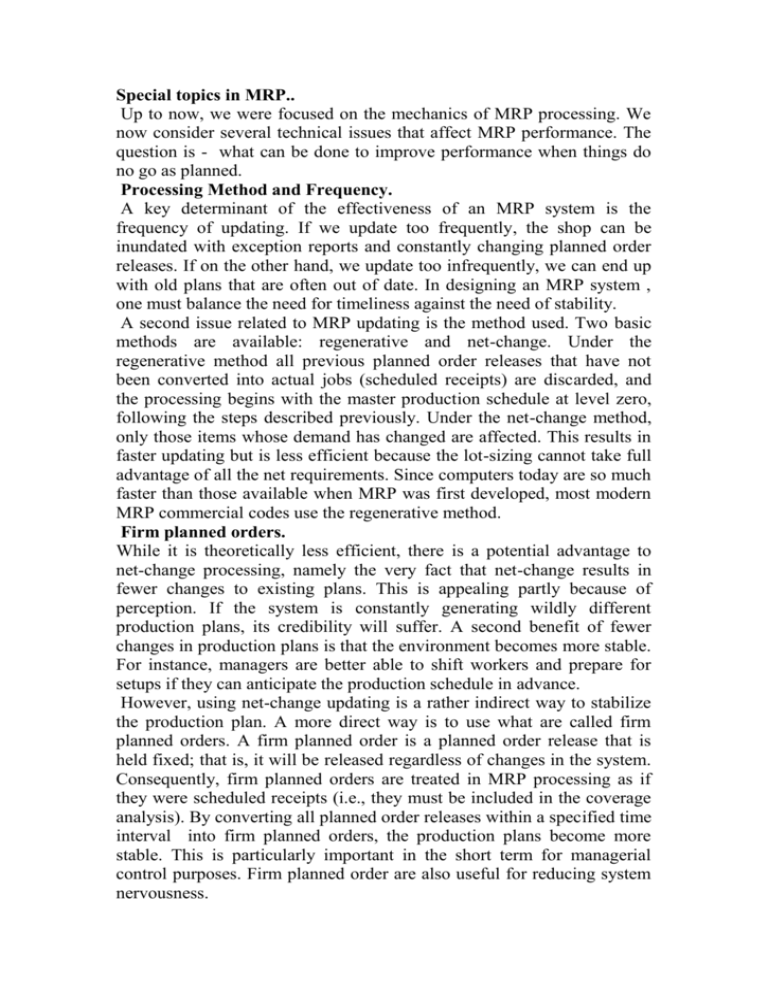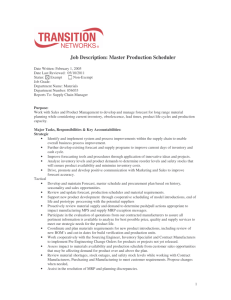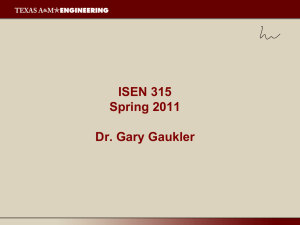Lot-sizing techniques
advertisement

Special topics in MRP.. Up to now, we were focused on the mechanics of MRP processing. We now consider several technical issues that affect MRP performance. The question is - what can be done to improve performance when things do no go as planned. Processing Method and Frequency. A key determinant of the effectiveness of an MRP system is the frequency of updating. If we update too frequently, the shop can be inundated with exception reports and constantly changing planned order releases. If on the other hand, we update too infrequently, we can end up with old plans that are often out of date. In designing an MRP system , one must balance the need for timeliness against the need of stability. A second issue related to MRP updating is the method used. Two basic methods are available: regenerative and net-change. Under the regenerative method all previous planned order releases that have not been converted into actual jobs (scheduled receipts) are discarded, and the processing begins with the master production schedule at level zero, following the steps described previously. Under the net-change method, only those items whose demand has changed are affected. This results in faster updating but is less efficient because the lot-sizing cannot take full advantage of all the net requirements. Since computers today are so much faster than those available when MRP was first developed, most modern MRP commercial codes use the regenerative method. Firm planned orders. While it is theoretically less efficient, there is a potential advantage to net-change processing, namely the very fact that net-change results in fewer changes to existing plans. This is appealing partly because of perception. If the system is constantly generating wildly different production plans, its credibility will suffer. A second benefit of fewer changes in production plans is that the environment becomes more stable. For instance, managers are better able to shift workers and prepare for setups if they can anticipate the production schedule in advance. However, using net-change updating is a rather indirect way to stabilize the production plan. A more direct way is to use what are called firm planned orders. A firm planned order is a planned order release that is held fixed; that is, it will be released regardless of changes in the system. Consequently, firm planned orders are treated in MRP processing as if they were scheduled receipts (i.e., they must be included in the coverage analysis). By converting all planned order releases within a specified time interval into firm planned orders, the production plans become more stable. This is particularly important in the short term for managerial control purposes. Firm planned order are also useful for reducing system nervousness. Troubleshooting in MRP. A wise man named Murphy once said, „If something can go wrong, it will go wrong”. In an MRP system, there are many things that can go wrong. Jobs can finish late, parts can be scrapped, demand can change, and so on. As a result, over the years MRP system have acquired features to assist the planner as conditions change. Examples include the techniques of pegging and bottom-up replanning. Pegging allows the planner to see the source of demand that results in a given planned order release. It is facilitated by providing a link from the gross requirements of an item to all of its sources of demand. For example, consider the planned order release of Lot-sizing techniques Different mathematical models are designed to assist decision making at all level of plant design and control. These models became standard subjects in operation management (OM). OM problem areas, including inventory control, scheduling, capacity planning, forecasting, quality control, and equipment maintenance became part of the business and engineering curricula. In this chapter the mathematical modeling approach to inventory control is described. The reason for doing this are: 1. The inventory models are among the oldest results of the OM field and are almost universally known. 2. Inventory plays a key role in the logistical behaviour of virtually all manufacturing systems. 3. These classical inventory results are central to more modern techniques of manufacturing management, such as material requirement planning (MRP), justin-time (JIT), and time-based competition (TBC). The Economic Order Quantity (EOQ) model On of the earliest application of mathematics to factory management was the work of Ford W. Harris on the problem of setting manufacturing lot sizes. The problem is originated from fact that of a factory producing various products where switching between products entails a costly set-up, machines had to be adjusted, clerical work had to be done, and material might be wasted. Set-up cost is defined as the sum of total of the labour and material cost to ready the shop to produce a product. If we make changeovers on the line infrequently, we will keep setup cost low. However, infrequent set-ups also imply that we will produce huge lots of a given type of components before switching to a different one. If demand for components is relatively steady, then a substantial portion of each lot will be held in inventory before being sold. Money tied up in this inventory is unavailable for use elsewhere. To reduce this cost we could reduce inventory by producing in smaller lots. This is the basic dilemma behind the EOQ model. In order to derive a lot size formula the following assumptions about the manufacturing system are made: Production is instantaneous. There is no capacity constraint and the entire lot is produced simultaneously. Delivery is immediate. There is no time lag between production and availability to satisfy demand. Demand is deterministic. There is no uncertainty about the quantity or timing of demand. Demand is constant over time. A production run incurs a constant set-up cost. Products can be analysed separately. With these assumptions, we can develop the EOQ model for computing optimal production lot sizes. The notation we will use is as follows: D = Demand rate (in units per year) c = unit production cost, not running set-up or inventory cost A = constant set - up to produce (purchase) a lot h = holding cost; if the holding cost consists entirely of interest on money tied up in inventory, then h = ic, where i is an annual interest rate Q = lot size (in units). The total (inventory, set-up, and production) cost per unit of product can be expressed Y (Q) hQ A c 2D Q as: Taking the derivative of Y(Q) and setting the result equal to zero, yields dY (Q) h A 2 0 dQ 2D Q The lot size Q* that minimises Y(Q) is: 2 AD h This square root formula is the well-known economic order quantity (EOQ) (also referred as the economic lot size). The obvious implication of the above result is that the optimal order quantity increases with the square root of the set-up cost or demand rate and decreases with the square root of the holding cost. Increasing the lot size increases the average amount of inventory on hand, but reduces the frequency of ordering. Q* To examine the sensitivity of the cost to lot size, we begin by substituting Q* for Q into equation for Y (but omitting the c term, since this is not affected by lot size) and find that the minimum holding plus set-up cost per unit is given by Y * Y (Q * ) hQ * A * 2D Q 2 Ah D To convert this into an annual cost, we multiply by D, which yields AnnualCost 2 ADh Now, suppose that instead of using Q*, we use some other arbitrary lot size, Q´ = (1+α)Q*. Here, α represent the fractional error, which could be positive or negative. Hence, the ratio of the annual cost using lot size Q` to that using lot size Q* is given by hQ ' AD ' 2 Q 1 Q ' Q* ( ) 2 Q* Q ' 2 ADh Suppose that Q` = 2Q* then ratio of the resulting holding plus set-up cost to the optimum is 1.25. That is, a 100 per sent error in lot size results in a 25 per sent error. This is useful in multi-product settings, where it is desirable to order such that different products are frequently replenished at the same time (e.g. to facilitate sharing of delivery trucks). Harris's original formula has been extended in variety of ways over years. One of the earliest extensions was to the case where replenishment is not instantaneous, but, instead, there is a finite but constant and deterministic production rate P. This model is sometimes called the economic production lot (EPL) model. Using the same notation as that used for the EOQ model we can analogically find the cost minimising value of Q 2 AD h(1 D ) P Which is identical to the EOQ formula. Q* Dynamic Lot Sizing Lot-for lot and Fixed Order Quantity techniques The dynamic models consider the problem of determining production lot sizes when demand is deterministic but varies with the time. T Problem formulation To specify the problem and model, we will make use of the following notations: t = A time period (e.g., day, week, month); we will consider t = 1,2,…,T, where T represent the planning horizon. Dt = Demand in period t (in units). Ct = Unit production cost (in kroon's per unit), not counting set-up or inventory costs in period t. At = Set-up (order) cost to produce (purchase) a lot in period t. Ht = Holding cost to carry a unit of inventory from period t to period t+1. It = Inventory (in units) left over at the end of period t. Qt = The lot size (in units) in period t (the decision variable). The basic problem is to satisfy all demands at minimal cost. The only controls are the production quantities. The data for used examples are given in table X.X. To keep things simple, the set-up cost (At), the production cost (Ct), and the holding cost (Ht) are all constant over time. Table X.X. Data for Lot-sizing example t 1 2 3 4 5 Dt 20 50 10 50 50 Ct 10 10 10 10 10 At 100 100 100 100 100 Ht 1 1 1 1 1 6 10 10 100 1 7 20 10 100 1 8 40 10 100 1 9 20 10 100 1 10 30 10 100 1 The simplest dynamic lot-sizing rule is, known as lot-for-lot, states that the amount to be produced in a period id equal to that period's requirements. Table X.X shows the production schedule and resulting costs for this policy. Since we never carry inventory, the total cost is just that of the 10 set-ups, or 1000 kroons. Table X.X. Lot-for-Lot solution to example t 1 2 3 4 5 Dt 20 50 10 50 50 Qt 20 50 10 50 50 It 0 0 0 0 0 Set-up cost 100 100 100 100 100 Holding 0 0 0 0 0 cost Total cost 100 100 100 100 100 6 10 10 0 100 0 7 20 20 0 100 0 8 40 40 0 100 0 9 20 20 0 100 0 10 30 30 0 100 0 Total 300 300 0 1000 0 100 100 100 100 100 1000 Fixed order quantity Another policy would be to produce a fixed amount each time we perform a set-up. This is known as the fixed order quantity lot-sizing rule. Since there are 300 units to produce, one possible fixed order quantity would be 100 units. This would require three set-ups. Table X.X illustrates the production schedule and resulting costs for this policy. The total cost is 700 kroons. This is lower than cost from the lot-for-lot policy. There are different other (better) polices for dynamic lot sizing and for statistical Inventory Models (see /Wallace J. Hopp/, / Thomas E. Vollman/. Table X.X. Fixed Order Quantity solution to example t 1 2 3 4 5 6 7 Dt 20 50 10 50 50 10 20 Qt 100 0 0 100 0 0 100 It 80 30 20 70 20 10 90 Set-up cost 100 0 0 100 0 0 100 8 40 0 50 0 9 20 0 30 0 10 30 0 0 0 Total 300 300 300 Holding cost Total cost 80 30 20 70 20 10 90 50 30 0 400 180 30 20 170 20 10 190 50 30 0 700 Part-Period Balancing. Part-Period balancing (PPB) is a policy that combines the assumptions of the Wagner-Whitin paradigm with the mechanics of the EOQ. One of the properties of the EOQ solution to the lot-sizing problem is that it sets the average inventorycarrying cost equal to the setup cost. The idea of PPB is to balance (i.e. set equal) the inventory-carrying cost and setup cost. To describe this we need to define the notion of a part-period as the product of the number of parts in a lot times the number of periods they are carried in inventory. For instance, one part carried for 10 periods, 5 parts carried for two periods, and 10 parts carried for one period all represents 10 part-period and incur the same inventorycarrying cost. Part-period balancing seeks to make the carrying cost as close to the setup cost as possible. We can demonstrate this using the data for example. Quantity for period 1 20 70 80 130 Setup cost Part-Periods 100 100 100 100 0 50X1 50X1+10X2 50X1+10X2+50X3 Inventory Carrying Cost 50 70 220 The best suitable is the third solution we will produce 80 parts Quantity for period 4 Setup cost Part-Periods Inventory Carrying Cost 50 100 110 130 170 100 100 100 100 100 0 50X1 50X1+10X2 50X1+10X1+20X3 50X1+10X1+20X3+40X4 The best suitable is to produce 130 parts on period 4 Quantity for period Setup cost Part-Periods 8 40 100 0 60 100 20X1 90 100 20X1+30X2 The best suitable is to produce 90 parts on period 8 t Dt Qt It Set-up cost Holding cost Total cost 1 20 80 60 100 60 2 50 0 10 0 10 160 10 50 70 120 280 Inventory Carrying Cost 0 20 80 3 10 0 0 0 0 4 50 130 80 100 80 5 50 0 30 0 30 6 10 0 20 0 20 7 20 0 0 0 0 8 40 90 50 100 50 9 20 0 30 0 30 10 30 0 0 0 0 Total 300 300 0 180 30 20 0 150 30 0 580 In this case it will be possible to minimize the total cost up to 580 300 280





